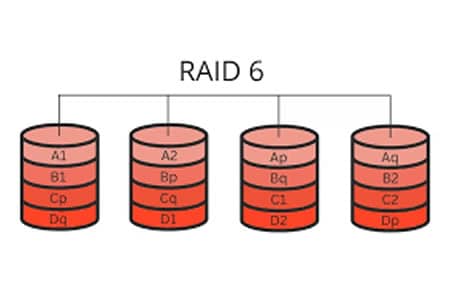Raid 6 Data Recovery
Raid 6 Data Recovery – RAID 6 stands out as one of the most robust and reliable options, offering dual parity protection against disk failures. However, even with this level of redundancy, data loss can still occur due to various factors such as hardware malfunctions, human errors, or natural disasters. In such scenarios, Raid 6 data recovery becomes essential to retrieve your precious data.

Understanding RAID 6:
RAID 6 is a setup that employs two independent parity blocks, distributed across different disks in the array. This configuration allows for the failure of up to two disks simultaneously without compromising data integrity. The dual parity scheme provides an additional layer of protection, making RAID 6 an ideal choice for mission-critical applications and environments where data loss can have severe consequences.
Common Causes of Data Loss in RAID 6:
Despite its robust design, RAID 6 arrays are not immune to data loss. Some of the common causes include:
- Multiple disk failures: While RAID 6 can tolerate up to two disk failures, any additional disk failures will result in data loss.
- Improper array rebuilding: Incorrect or incomplete array rebuilding after a disk failure can lead to data corruption or loss.
- Human errors: Accidental deletion, formatting, or mishandling of disks can compromise data integrity.
- Power surges or system crashes: Unexpected power outages or system crashes during critical operations can corrupt data.
- Logical errors: Software bugs, firmware issues, or configuration errors can cause data loss.
Raid 6 Data Recovery Process:
Recovering data from a failed RAID 6 array is a complex process that requires specialized expertise and tools. Here’s a general overview of the recovery process:
- Evaluation and diagnosis: The first step is to evaluate the extent of the failure and diagnose the root cause. This involves analyzing the RAID configuration, identifying failed disks, and assessing the overall condition of the array.
- Data extraction: Once the failed disks have been identified, the next step is to extract data from the remaining functional disks. This process involves carefully reading the data from the disks and reconstructing the original information using the parity information.
- Array rebuilding: If necessary, the RAID array may need to be rebuilt using the recovered data and replacement disks. This step ensures that the recovered data is accessible and usable.
- Data recovery and verification: After the array has been rebuilt, the recovered data is carefully inspected and verified for integrity and completeness. Any missing or corrupted files are addressed using advanced data recovery techniques.
Best Practices for Raid 6 Data Recovery:
To maximize the chances of successful Raid 6 data recovery, it’s essential to follow these best practices:
- Act promptly: Time is of the essence when dealing with data loss scenarios. The sooner you initiate the recovery process, the higher the chances of successful data retrieval.
- Seek professional assistance: Raid 6 data recovery is a complex and delicate process. It’s highly recommended to seek assistance from professional data recovery experts in Kenya who have the necessary tools, expertise, and experience.
- Avoid DIY attempts: Attempting to recover data from a failed RAID 6 array on your own can lead to further data loss or permanent damage. Leave it to the professionals.
- Maintain backups: While RAID 6 provides redundancy, it’s always a good practice to maintain regular backups of your critical data. This can greatly mitigate the impact of data loss and simplify the recovery process.
- Follow best practices: Implement best practices for RAID maintenance, such as regularly monitoring the array, replacing aging disks, and adhering to proper shutdown and startup procedures.
Raid 6 data recovery is a complex and challenging process, but it’s often the only way to retrieve valuable data from a failed array. By understanding the intricacies of RAID 6, the common causes of data loss, and the recovery process, you can better prepare for and handle such situations. Remember, seeking professional assistance and following best practices are crucial for successful data recovery and minimizing the risk of further data loss.

